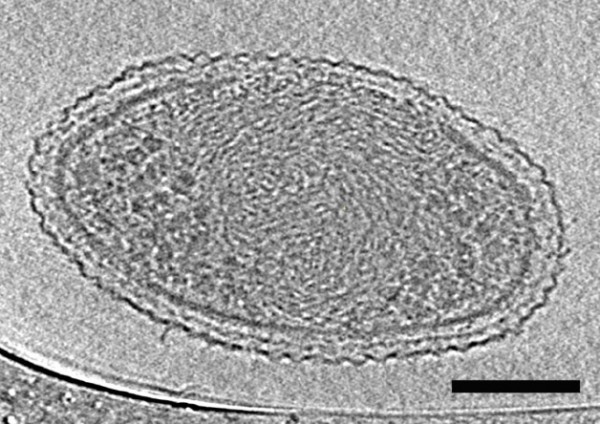First Detailed Image of Smallest Life Form on Earth Revealed
| Ana Verayo | | Mar 02, 2015 06:33 AM EST |
(Photo : Berkeley Lab) This cryo-electron tomography image reveals the internal structure of an ultra-small bacteria cell.
Researchers claim they've successfully captured microscopic images of the smallest bacterial forms of life to ever exist on the Earth.
Researchers from the Lawrence Berkeley National Laboratory under the U.S. Department of Energy and University of California, Berkeley said their work finally paid off and confirmed they have evidence of the most minute forms of bacteria to exist that's been in question for 20 years.
Like Us on Facebook
Using electron microscopy, several kinds of bacteria were carefully examined, including three microbial phyla poorly understood so far.
These bacteria are apparently found in very common places, specifically in groundwater. Researchers were surprised by they could easily find the bacteria and by the even smaller size of the bacteria that were smaller previously thought.
The cells are so miniscule they have an average volume of 0.009 cubic microns. This means that 150 bacteria can easily fit into one single cell of Escherichia coli.
To further elaborate how small these bacteria are, researchers say over 150,000 of them can be placed on the tip of a human hair.
Researchers believe these are the smallest cells or any form of life to ever exist and still possess internal processes and material to sustain life.
The bacteria resemble densely packed spiral shapes similar to DNA. They apparently function with just a few ribosomes and a minimal metabolism and rely on other bacteria to subsist.
These newly discovered ultra small bacteria shows a subset of microbial life on Earth that scientists almost know nothing about, according to Jill Banfield from the Berkeley Lab and a UC Berkeley professor of Earth and Planetary Science.
The bacteria can be found in many environments and probably play important roles in microbial ecosystems.
Researchers collected these ultra small cells through a small series of filters with a size of 0.2 microns, which is the same size f filters used to sterilize water. The groundwater sample was teeming with tiny microbes and scientists were concerned if cells of this minute size can even be alive.
Study co author Birgit Luef from the Norwegian University of Science and Technology said this study is not a consensus about how small a free living organism can reach. This research, however, represents the pivotal first step in characterizing the size and structure of ultra small cells.
This study was published in the journal, Nature Communications.
TagsFirst Detailed Image of Smallest Life Form on Earth Revealed, smallest bacteria on earth, ultra small bacteria, first detailed image evidence ultra small smallest bacteria life form earth
©2015 Chinatopix All rights reserved. Do not reproduce without permission
EDITOR'S PICKS
-

Did the Trump administration just announce plans for a trade war with ‘hostile’ China and Russia?
-

US Senate passes Taiwan travel bill slammed by China
-

As Yan Sihong’s family grieves, here are other Chinese students who went missing abroad. Some have never been found
-

Beijing blasts Western critics who ‘smear China’ with the term sharp power
-

China Envoy Seeks to Defuse Tensions With U.S. as a Trade War Brews
-

Singapore's Deputy PM Provides Bitcoin Vote of Confidence Amid China's Blanket Bans
-

China warns investors over risks in overseas virtual currency trading
-

Chinese government most trustworthy: survey
-

Kashima Antlers On Course For Back-To-Back Titles
MOST POPULAR
LATEST NEWS
Zhou Yongkang: China's Former Security Chief Sentenced to Life in Prison

China's former Chief of the Ministry of Public Security, Zhou Yongkang, has been given a life sentence after he was found guilty of abusing his office, bribery and deliberately ... Full Article
TRENDING STORY

China Pork Prices Expected to Stabilize As The Supplies Recover

Elephone P9000 Smartphone is now on Sale on Amazon India

There's a Big Chance Cliffhangers Won't Still Be Resolved When Grey's Anatomy Season 13 Returns

Supreme Court Ruled on Samsung vs Apple Dispute for Patent Infringement

Microsoft Surface Pro 5 Rumors and Release Date: What is the Latest?










